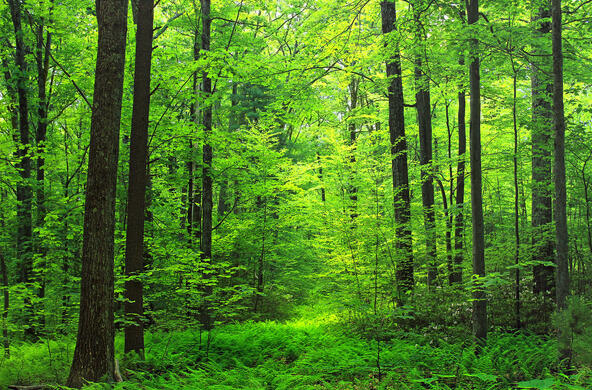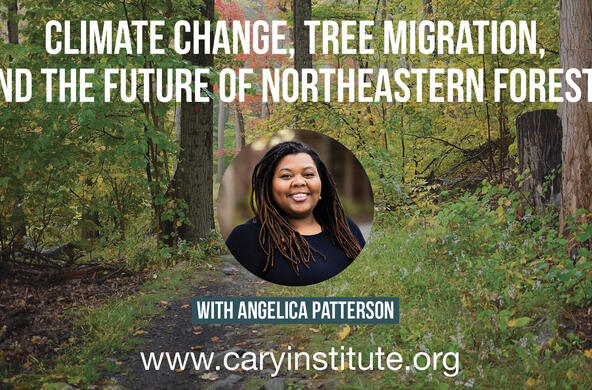When Chris Standley received a tip that some ash trees within the Mohonk Preserve might be infested by a devastating insect, he grabbed a drawknife and peeled away the bark.
There underneath, Standley, the preserve's coordinator of applied conservation, found evidence of the emerald ash borer, the Asian insect that is wiping out ash trees across the country.
"Honestly," he said, "I wasn't surprised."
Indeed, when it comes to harboring non-native damaging forest pests, Ulster County is one of the most infested counties in New York, which also just happens to be one of the most infested states in the nation.
Data provided to the Poughkeepsie Journal by the U.S. Forest Service shows Ulster is beset with 41 distinct invasive bugs and blights. Ulster ranks second only to Suffolk County, which has 42.
Dutchess is tied for third with 40.
By comparison, some counties in the southwest have fewer than five invasive species.
The reason, scientists say, is twofold.
First, New York is a significant port of entry for international trade that is responsible for the spread of the pests. And second, the state's forests are diverse.
"If you go into a typical western forest, a lot will have just one tree species," said Andrew Liebhold, a research entomologist with the Forest Service. "You go into your backyard in Poughkeepsie and walk into a woodlot, you might have 30 species of trees there."
On top of that, many of the state's trees are related to species in Europe and Asia. So like other immigrants who have come through New York City, the bugs have not had to go far to find places where the food is familiar
The data highlight both the urgency of the problem and the challenges scientists and policymakers face in dealing with it.
That is why a team of experts recently met at the Cary Institute of Ecosystem Studies in Millbrook to study the science and consider solutions. The yearlong project is being funded by the Forest Service and two charitable foundations.
"We've assembled a team of ecologists, entomologists, economists and policy experts," said Gary Lovett, a forest ecologist at the Cary Institute and a co-leader of the project.
The list of pests includes insects — the emerald ash borer, European bark beetle, spongy moth and hemlock woolly adelgid, among others — and pathogens such as beech bark disease.
Some of the pests can spread like a deadly pandemic.
Chestnut blight was first discovered in 1904 in New York City. It is believed the fungus was introduced when Asian chestnut trees, which are more resistant, were brought to America in the 19th century.
In 50 years, the disease destroyed more than 9 million acres — about 14,000 square miles — of American chestnut forest from Mississippi to Maine.
Chestnuts once accounted for 25 percent of all standing timber in eastern forests, according to the Forest Service. Now, just stumps and disease-ridden shrubs remain.
Scientists believe the same fate awaits ash trees, thanks to the emerald ash borer. The green beetle burrows under bark to lay its eggs. With the food supply system chokes off, the trees die in two to four years.
The beetle has killed 50 million ash trees in Michigan since it was discovered there in 2002, according to the New York Department of Environmental Conservation.
Locally, it has been found in Dutchess and Ulster counties. And experts say there is little that can be done to stop it. Ash trees can be treated with an insecticide, but the effect is temporary and experts point out it would be impractical to inoculate meaningful numbers of the trees.
What's more, while chestnut blight virtually wiped out one species — the American chestnut — the emerald ash borer is expected to kill off 20 species of ash trees.
"It's not looking like there are going to be many survivors," said Liebhold, the Forest Service entomologist.
The impacts are not limited to the trees. On the Shawangunk Ridge, hemlocks provide cover for streams and other wet areas, according to Cara Lee, director of the Shawangunk Ridge program for The Nature Conservancy.
Hemlocks are threatened by hemlock wooly adelgid, a type of plant lice that sucks sap and nutrients from hemlock foliage.
"If (the hemlocks) are hit by an invasive insect that kills them, it has a cascading effect in terms of affecting water quality, what lives in the stream and recreational use," Lee said. "So one invasive species can affect a whole range of values."
There are economic impacts to consider as well.
Ash trees are common in village and city centers, as well as the yards of homeowners.
Removing the dead trees before they fall on something will be a considerable financial burden on municipalities and homeowners, experts say.
In 2010, the Forest Service estimated the emerald ash borer will cost communities in a 25-state area as much as $10.7 billion for the treatment, removal and replacement of more than 17 million ash trees in developed areas by the end of the decade.
In many cases, once a pest emerges, there is little that be done to stop it.
So experts are shifting their efforts to finding ways to keep them from coming in, and to slowing the spread.
The first step, they say, is educating the public. Last month, the state Department of Environmental Conservation held a weeklong effort aimed at raising awareness of the emerald ash borer.
The bug is often introduced to new areas through the transportation of infested firewood. State regulations restrict the movement of untreated firewood to 50 miles.
"The beginning of the camping season is quickly approaching and it is important to remind travelers in New York state to use only local firewood," DEC Commissioner Joseph Martens said.
Experts also caution against the purchase of nonnative plant species for home gardens.
But many believe larger solutions — such as tighter restrictions on imports — must be implemented at the state and federal level.
"When we are using these global market trade systems, we are affecting the landscape," Standley of the Mohonk Preserve said.
The group that met recently at Cary will provide recommendations that could be used to shape future import regulations.
All agree that the composition of local forests will be considerably different in coming decades.
What is unclear is whether the trees that replace ashes and hemlocks will be challenged by some new invader, as well as how the changes will affect the forests' complex and interconnected web of life.
"Often by the time we are really aware of what it is, it is unstoppable," Lee said. "That is why it is so important that people are studying it and understanding how these populations are introduced and what the impact is on native plants and animals."
TOP 5 scariest forest pests
1. Hemlock woolly adelgid. A tiny aphid-like insect that was introduced from Asia on trees imported for nurseries. It has killed many of the hemlock trees in the southern Appalachians and the mid-Atlantic states, and is spreading locally now. Hemlocks are the most long-lived species of local old-growth forests and are particularly important along stream banks.
2. Emerald ash borer. A small beetle imported from Asia in wooden crates and pallets, it was introduced in Michigan and has been spreading across the Midwest and into the Northeast. It recently arrived in Ulster and Dutchess counties. It attacks and kills all types of ash trees, which are important in upland and wetland forests.
3. Asian long-horned beetle. A large beetle introduced from Asia in wooden crates, pallets, and other packing material. While not yet widespread, there have been serious outbreaks of this pest in New York City, New Jersey, Chicago, Toronto and other areas. A recent outbreak in Worcester, Massachusetts, has required the removal of more than 30,000 trees from that city so far. It feeds on many different types of hardwood trees, but prefers the maples, which are the most dominant trees in our region.
4. Sudden oak death. This disease, caused by a fungus-like organism, was imported from Asia on live plants for nurseries. It is currently widespread in California and Oregon, where it kills oaks and tan oaks, but is not yet widespread in the East. Eastern oak trees, which are very important in the Hudson Valley and southward, are known to be susceptible, so if it becomes widespread it could cause major damage.
5. The next one. Somewhere right now there is an insect or disease just arriving in our country on a live tree imported for nurseries or in the wooden crates inside a shipping container. It will probably not be found by our customs or agricultural inspection agents. Will it establish a population here in this country? What species of tree will it attack? How serious will the damage be?
Source: Gary Lovett, Cary Institute of Ecosystem Studies






